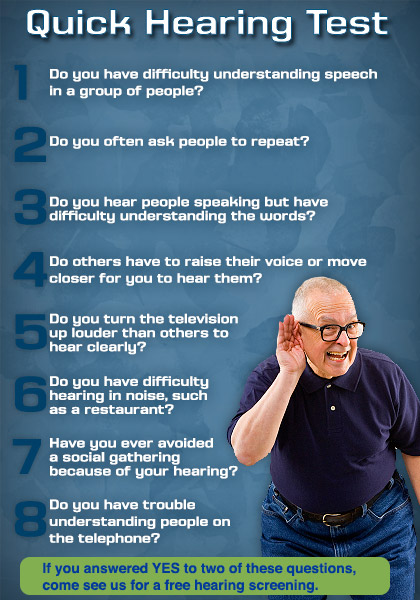Genral Information About Hearing
How does hearing work?
Hearing begins when the outer ear, the visible portion of the ear, channels sound waves down the auditory canal, the tube-like passageway leading into the ear. The middle ear lies at the end of the auditory canal. It is composed of the eardrum and three small bones, commonly referred to as the hammer, the anvil and the stirrup. When sound waves hit the eardrum, it vibrates and, in turn, moves the hammer. The hammer moves the anvil, which moves the stirrup, transmitting the vibrations into the inner ear. The middle ear functions to amplify sound, which is why significant hearing loss can result from any disruption in any of the parts.
The inner ear consists of the cochlea and the nerve of hearing. It converts sound waves into nerve impulses that travel to the brain via the movement of tiny hair cells. The brain, in turn, allows us to hear…as long as the message it is receiving is not distorted due to problems in the process just described.
What causes hearing loss?
The type of hearing loss in any one person depends upon where in the ear the problem occur. The three main types are conducive, sensorineural, and mixed losses.
Conductive: A problem in the outer or middle ear causes conductive hearing loss. A conductive loss prevents sound from reaching the nerves in the inner ear. Common causes include:
- Conditions associated with middle ear pathology such as fluid in the middle ear from colds, allergies, poor eustachian tube function, ear infection, perforated eardrum, benign tumors
- Impacted earwax
- Infection in the ear canal
- Presence of a foreign body
- Absence or malformation of the outer ear, ear canal, or middle ear
Sensorineural: Damaged nerves in the inner ear cause senorineural hearing loss. Sensorineural losses cannot be reduced or eliminated by surgery. There are many causes, differing by age of onset.
Before or During Birth:
- Perinatal infections such as rubella, herpes, toxoplasmosis, syphilis, cytomegalovirus (CMV)
- Heredity
- Asphyxia or lack of oxygen at birth.
- Possible association with birth weight of less than 1500 grams.
- Possible association with defects of the head and neck
Later Onset:
- Bacterial meningitis
- Ototoxicity (drug induced)
- Intense or excessive noise
- Physical damage to head or ear
Mixed: Sometimes, people will have problems both in the inner ear and in the outer or middle ear. This type of hearing loss is known as a mixed loss.
Degrees of Hearing Loss
Hearing loss is measured in decibels (dB). The softest sounds are made at zero dB, and the loudest are 120 dB. Normal speech is around 50 dB.
The table shows the various degrees of hearing loss. Hearing loss is never given in percentages, only in decibels.
| Degree of hearing loss | Hearing loss range (dB HL) |
|---|---|
| Normal | 0 to 15 |
| Slight | 16 to 25 |
| Mild | 26 to 40 |
| Moderate | 41 to 55 |
| Moderately severe | 56 to 70 |
| Severe | 71 to 90 |
| Profound | 91+ |

Why choose All Ears Audiology?
- Providing services in the City of Orange for over 28 years.
- Trusted and highly recommended by the local physicians in the community.
- Patient, caring and thorough personal attention in diagnosing and rehabilitation for the patients.
- 60-Day Trial Period on all hearing aid purchases
- 3 year Repair and Loss & Damage insurance included on all models and sizes (including basic technology)*
*Phonak & Unitron

